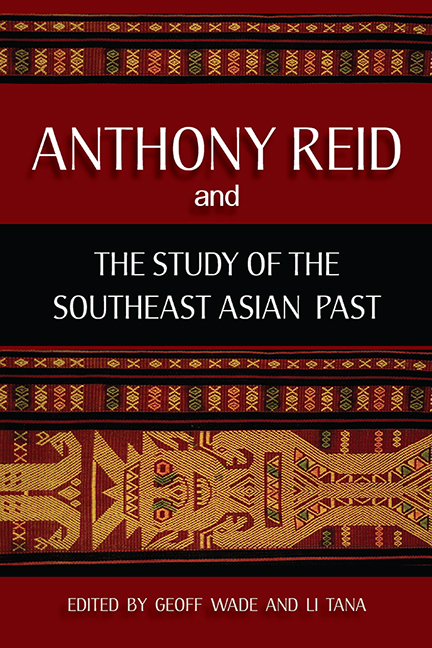Book contents
- Frontmatter
- Contents
- Acknowledgements
- The Contributors
- PART I Introduction
- PART II The Scholarship of Anthony Reid
- PART III Southeast Asia in the World
- 3 Southeast Asia and Eurasia during a Thousand Years
- 4 A Two-Ocean Mediterranean
- 5 The Concepts of Space and Time in the Southeast Asian Archipelago
- 6 Dominion over Palm and Pine: Early Indonesia's Maritime Reach
- PART IV Early Modern Southeast Asia
- PART V Modern Southeast Asia
- Appendix
- Index
- Plate section
3 - Southeast Asia and Eurasia during a Thousand Years
from PART III - Southeast Asia in the World
Published online by Cambridge University Press: 21 October 2015
- Frontmatter
- Contents
- Acknowledgements
- The Contributors
- PART I Introduction
- PART II The Scholarship of Anthony Reid
- PART III Southeast Asia in the World
- 3 Southeast Asia and Eurasia during a Thousand Years
- 4 A Two-Ocean Mediterranean
- 5 The Concepts of Space and Time in the Southeast Asian Archipelago
- 6 Dominion over Palm and Pine: Early Indonesia's Maritime Reach
- PART IV Early Modern Southeast Asia
- PART V Modern Southeast Asia
- Appendix
- Index
- Plate section
Summary
In 1792 the French monarchy imploded. Between 1799 and 1815 a new Parisian regime improved administrative efficiency, while dramatically extending French territory. French conquests precipitated imitative reforms across Europe and a permanent reduction in the number of independent states.
Between 1752 and 1786 the Burmese, Siamese, and Vietnamese kingdoms all collapsed. In each realm, a more dynamic leadership succeeded in rebuilding state authority and extending its territorial writ. Ensuing wars between reinvigorated empires accelerated competitive reform and permanently reduced the number of independent mainland Southeast Asian states.
How shall we explain these synchronized parallels between far-flung sectors of Eurasia? Surely, one might reply, no explanation is needed: the cultural contexts were so different, the political and interstate systems so unique, as to render these parallels curious, but basically meaningless coincidence.
Closer consideration, however, suggests that more was involved. In fact, the late 1700s ended the third and initiated the last of four cycles of consolidation which were synchronized between much of Europe and mainland Southeast Asia and which spanned the better part of a millennium. The first synchronized consolidation, marked by extremely rapid economic growth, began in the tenth century and concluded with a generalized political and social breakdown lasting, depending on local context, for much of the period from the mid-thirteenth to the mid-fifteenth century. Political integration resumed in the mid-1400s, but between 1550 and 1610 the chief Southeast Asian states, as well as France and Russia again collapsed. Reforms in the early and mid-seventeenth century inaugurated a third phase of consolidation — one that ended with the late eighteenth century collapse and dramatic revivals with which I opened.
Why, then, should distant regions, with no obvious cultural or economic links, have experienced more or less coordinated cycles? Moreover, why did interregna in both mainland Southeast Asia and much of Europe become ever shorter and less disruptive? In virtually every case, the thirteenth/fifteenth century collapse was longer and more dislocative than the late sixteenth crisis, which was more destructive than late eighteenth century disturbances.
Or to reverse the terms of inquiry so as to pose a yet more basic problem: Why in the second millennium did societies in mainland Southeast Asia as well as Europe grow more politically and culturally coherent? Whereas Europe as a whole in 1450 had some 500 political units, by the late nineteenth century the number was closer to 30.
- Type
- Chapter
- Information
- Anthony Reid and the Study of the Southeast Asian Past , pp. 47 - 68Publisher: ISEAS–Yusof Ishak InstitutePrint publication year: 2012

